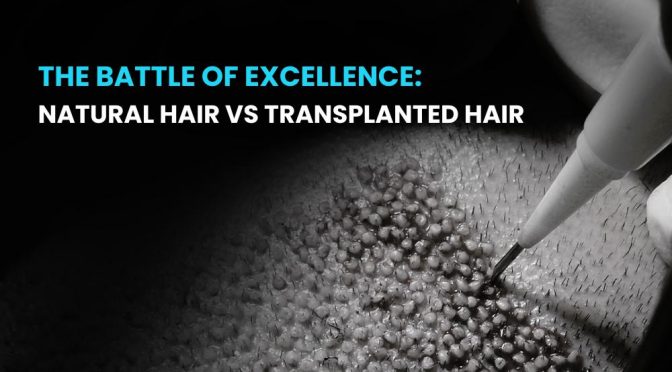-
Languages ENGLISH
-
Call 24/7 +39 030 764 1043
-
Open Hours Mon - Sat: 9am to 6pm

In recent years, the field of hair restoration has seen significant advancements. Offering more effective and natural-looking solutions to hair loss problems. This article will provide an in-depth comparison of natural hair vs transplanted hair. Shedding light on the intricacies of various hair transplantation procedures and their outcomes.
Hair transplantation is a medical procedure that involves relocating hair follicles from one part of the body, known as the ‘donor site,’ to the balding or thinning area, referred to as the ‘recipient site.’ The procedure leverages the fact that the hair in the donor area is resistant to the hormones causing baldness.
Primarily, two types of hair transplantation methods are commonly adopted: Direct Hair Implantation (DHI) and Follicular Unit Extraction (FUE). Both techniques aim to mimic natural hair growth patterns, leading to a seamless integration of transplanted hair with the existing ones, ensuring an aesthetically pleasing appearance.
Natural hair refers to hair that grows directly from your scalp without any medical intervention. This hair grows in follicular units, which are groups of 1-4 hairs, and the characteristics of this hair, such as color, texture, and growth rate, are determined by your genetics.
When we talk about the comparison of natural hair vs transplanted hair, it’s essential to remember that transplanted hair is, in fact, your own hair, relocated from another part of your scalp. Hence, it possesses the same characteristics as your natural hair.
One of the primary concerns when considering hair transplantation is whether the results will look natural. Pioneers in the field, such as Dr. Levent Acar, have made immense strides in achieving natural-looking results through meticulous hairline design, precise follicular unit placement, and innovative techniques like Sapphire DHI.
The use of advanced tools like Sapphire DHI implanter pens allows for the precise placement of individual follicular units, ensuring the hair grows in the same direction as your natural hair, leading to a seamlessly blended and natural look.
Despite the impressive advancements in the field, hair transplantation does come with its own set of limitations. The success of the procedure largely depends on the availability of a sufficient number of healthy hair follicles in the donor area and the ability of the recipient site to support hair growth.
Moreover, hair transplantation does not stop the progression of hair loss or thinning. It’s also critical to remember that transplant density is limited by the total number of grafts that can be harvested and the blood supply of the scalp to sustain these grafts.
The results of hair transplant surgery start becoming visible within 2 to 3 months post-operation. Most patients observe noticeable hair growth between 6 and 9 months. The transplanted hair will fall out between 2 and 8 weeks after the surgery. It is a normal part of the process, called shock loss, and new hair growth will begin thereafter.
To maintain the results of hair transplantation and to slow down further hair loss or thinning, certain medications might be recommended by your dermatologist. These include Finasteride, a pill that inhibits the conversion of testosterone to dihydrotestosterone (DHT). Also Minoxidil, a topical application that extends the growth phase of hair.
Additionally, treatments like Hair Regeneration, which uses extracellular matrix and platelet-rich plasma, can thicken existing hair and manage progressive hair loss, ensuring the longevity of your transplant results.
In the battle of natural hair vs transplanted hair, it’s important to remember that the transplanted hair is your natural hair, relocated to a different part of your scalp. Hence, it grows, looks, and feels like your natural hair.
The key to achieving truly natural-looking results lies in choosing an experienced hair transplant surgeon who can artfully design the hairline, precisely place the grafts, and use advanced techniques to ensure the best possible outcome.
It’s natural to have questions about such a significant decision. Let’s address some common queries:
A well-executed hair transplant is virtually undetectable. Even hairdressers and barbers usually can’t tell you’ve had a transplant unless you tell them.
Yes, once your scalp has healed after the transplant, you can cut, style, and color your transplanted hair just like your natural hair.
Most hair transplants are done under local anesthesia, so you shouldn’t feel any pain during the procedure. You may have some discomfort or swelling during the recovery period, but this is usually manageable with over-the-counter pain relievers.
Hair transplants are permanent. The transplanted hairs are resistant to the hormone that causes male or female pattern baldness, so they will not thin over time as the rest of your hair might.
In conclusion, the comparison of natural hair vs transplanted hair essentially boils down to their location. The transplanted hair is your own hair, moved from a donor site to a recipient site on your scalp. Thus, with accurate hairline design, precise graft placement, and post-transplant care, achieving a natural-looking head of hair is a real possibility. However, it’s crucial to remember that hair transplants are not a cure for ongoing hair loss. Additional treatments may be necessary to maintain the results over time as part of the aftercare process.
Decoding the Connection: Vaping And Hair Loss
Curious to know how your hair transplant would go? Connect with us today and let us help you understand each and everything with the help of the experts. & let us give you complete details with the help of a free consultation.
 Get free consultation
Get free consultation
Kindly fill up this form and we will get back to you at the earliest.